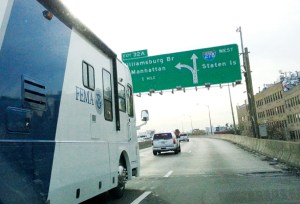Fast & Furious: The minute-by-minute, behind-the-scenes negotiations that led to this year’s F.E.M.A transaction
By Al Barbarino December 20, 2012 8:00 am
reprintsThe whirlwind negotiations between the federal emergency management agency and Muss Development to create an impromptu relief outpost in Queens in the days following Hurricane Sandy’s descent on New York would not have happened had it not been for one of the real estate industry’s leading dynasties.
In a deal that would later come to symbolize the overall dedication of the city’s real estate titans, government officials and executives banged out terms for 200,000 square feet of temporary space at the Forest Hills Tower in a mere five days, a minor miracle in the world of office leasing.
 Initial contact between the entities was made on Wednesday, Oct. 31, and by Monday, Nov. 5, just five days later, hundreds of FEMA, Red Cross and U.S. Army Corps of Engineers employees were at work at the Forest Hills Tower, an asset Muss Development owns at 118-35 Queens Boulevard in Forest Hills.
Initial contact between the entities was made on Wednesday, Oct. 31, and by Monday, Nov. 5, just five days later, hundreds of FEMA, Red Cross and U.S. Army Corps of Engineers employees were at work at the Forest Hills Tower, an asset Muss Development owns at 118-35 Queens Boulevard in Forest Hills.
“The entire process took just a few days, which is unbelievable, since that would normally take between six to eight months,” said Jason Muss, principal at Muss Development, who gave The Commercial Observer a play-by-play account of the deal process.
On that Wednesday, the same day the lease for anchor tenant Con Edison and subtenant JetBlue expired, Mark Greenspan of CBRE contacted Muss Development through Ken Siegel of Jones Lang LaSalle. By Thursday, a three-hour tour was scheduled with officials and decision-makers of the United States General Services Administration, which acted on FEMA’s behalf.
“They looked at every square foot in the building, assessed all the logistics, telecomm, security and other things that were critical for what they needed,” Mr. Muss said. “They basically brought in specialists from all over the country to take this three-hour tour, and after the tour, the GSA concurred, given the location and quality of the space, that it was the right fit.”
“You can basically get to any of the disaster areas pretty quickly from this site,” he added.
On Friday morning, the general terms of the lease and all the other details that are normally discussed within a period of months were compressed into a single day, Mr. Muss said.
“GSA, our in-house counsel, CBRE and Ken Siegel from from JLL were basically on the phone back and forth into Friday night until they had an oral agreement,” he said. “At 4 o’clock Saturday, we got a lease from FEMA, and then our in-house counsel did a black-line edit by 6, and for about four or five hours our counsel and FEMA’s council went line by line and hammered out a lease. We sent it to FEMA Saturday night by 11 p.m.”
By Sunday, employees pooled from all over the nation began to filter into the building.
“If you look at the license plates in the building parking lot, it’s just amazing how diverse the employees are in terms of where they’re from,” Mr. Muss said.
FEMA ended up with 200,000 square feet on floors one through eight, 10 and 11, for a lease term of “several months,” with the option to extend.
FEMA spokesperson William Rukeyser, who spoke with The Commercial Observer just after the agency moved in, echoed the fact that location was a key to the selection of the space.
“The fact that this place is near a subway line and intersects two major highways is an obvious plus,” he said, noting proximity to JFK and LaGuardia airports, and access to the five boroughs and surrounding counties. “We have plenty of square footage, and it was empty and ready to be moved into in a hurry with almost no notice.”
It could be over a year before the agency is drawing up final reports and audits and fully out of the building, Mr. Rukeyser said, and Muss confirmed that his company would be able to accommodate that if necessary.
Ken Siegel of Jones Lang LaSalle represented Muss Development, and Mark Greenspan of the CBRE Group represented the agency.



